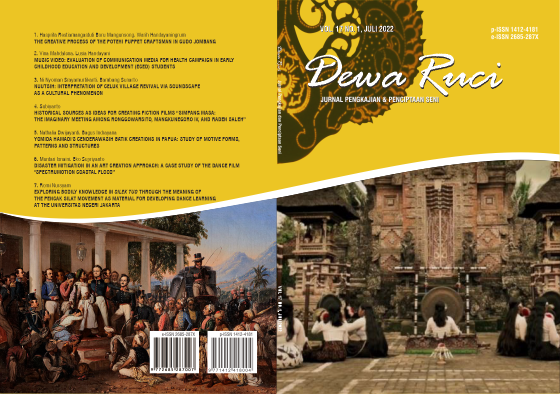Yomida Hamadi's cenderawasih batik creations in Papua: study of motive forms, patterns and structures
Main Article Content
Abstract
Downloads
Article Details
Authors who publish in Dewa Ruci: Jurnal Pengkajian dan Penciptaan Seni agree to the following terms:
- Authors retain copyright and grant the Dewa Ruci: Jurnal Pengkajian dan Penciptaan Seni right of first publication with the work simultaneously licensed under a Creative Commons Attribution License (CC BY-SA 4.0) that allows others to share (copy and redistribute the material in any medium or format) and adapt (remix, transform, and build upon the material) the work for any purpose, even commercially with an acknowledgment of the work's authorship and initial publication in Dewa Ruci: Jurnal Pengkajian dan Penciptaan Seni.
- Authors are able to enter into separate, additional contractual arrangements for the non-exclusive distribution of the journal's published version of the work (e.g., post it to an institutional repository or publish it in a book), with an acknowledgment of its initial publication in Dewa Ruci: Jurnal Pengkajian dan Penciptaan Seni.
- Authors are permitted and encouraged to post their work online (e.g., in institutional repositories or on their website) prior to and during the submission process, as it can lead to productive exchanges, as well as earlier and greater citation of published work (See The Effect of Open Access).
This work is licensed under a Creative Commons Attribution 4.0 International License
References
I. Nurhaida, A. Noviyanto, R. Manurung, and A. M. Arymurthy, “Automatic Indonesian’s batik pattern recognition using SIFT approach,” Procedia Comput. Sci., vol. 59, pp. 567–576, 2015, doi: 10.1016/j.procs.2015.07.547.
A. Grimshaw, E. Owen, and A. Ravetz, “Making do: the materials of art and anthropology,” in Between art and anthropology, Routledge, 2021, pp. 147–162. doi: 10.4324/9781003230694-13
B. Balakrishnan, “Exploring the impact of design thinking tool among design undergraduates: a study on creative skills and motivation to think creatively,” Int. J. Technol. Des. Educ., pp. 1–14, 2021, doi: 10.1007/s10798-021-09652-y.
H. H. Chartrand and C. McCaughey, “The arm’s length principle and the arts: an international perspective–past, present and future,” Who’s to Pay Arts, pp. 43–80, 1989. Available at: Google Scholar.
B. Sunarto, “Basic Knowledge and Reasoning Process in the Art Creation,” Open J. Philos., vol. 05, no. 05, pp. 285–296, 2015, doi: 10.4236/ojpp.2015.55036.
E. Bye, “A direction for clothing and textile design research,” Cloth. Text. Res. J., vol. 28, no. 3, pp. 205–217, 2010. doi: 10.1177/0887302X10371505
Y. Rukiah, “Visual Elements of" Semar Calligraphy" on Cirebon Glass Painting of Kusdono’s Work,” in IICACS: International and Interdisciplinary Conference on Arts Creation and Studies, 2019, vol. 1, pp. 43–47. doi: 10.33153/iicacs.v1i1.14
M. I. Tobroni, H. K. S. Wijasa, and S. Hamali, “Motive Design Creation’Bakau Forest Themes-Muara Gembong’Bekasi to Promote Micro and Small Enterprises Products,” in 2021 IEEE 7th International Conference on Computing, Engineering and Design (ICCED), 2021, pp. 1–5. doi: 10.1109/ICCED53389.2021.9664842
L. A. White, “The concept of culture,” Am. Anthropol., vol. 61, no. 2, pp. 227–251, 1959. doi: 10.1525/aa.1959.61.2.02a00040
M. K. Esonalievna, “The importance of the artistic image in the writer’s style expression,” Acad. an Int. Multidiscip. Res. J., vol. 11, no. 1, pp. 426–430, 2021, doi: 10.5958/2249-7137.2021.00075.6.
D. S. Collingridge and E. E. Gantt, “The quality of qualitative research,” Am. J. Med. Qual., vol. 23, no. 5, pp. 389–395, 2008, doi: 10.1177/1062860608320646.
J. Banfield, “Knowing between: generating boundary understanding through discordant situations in geographic–artistic research,” Cult. Geogr., vol. 23, no. 3, pp. 459–473, Jul. 2016, doi: 10.1177/1474474015591121.
P. W. Anggoro et al., “Virtual design and machining of core and cavity for fabrication of dining plate tableware with Kawung batik pattern,” Cogent Eng., vol. 9, no. 1, Dec. 2022, doi: 10.1080/23311916.2022.2084985.
G. N. Hafiza, I. Marzuki, and W. M. Z. Soliana, “The application of batik block motifs and marbling technique as pattern designs in contemporary batik,” in AIP Conference Proceedings, 2021, p. 020122, doi: 10.1063/5.0052330.
I. Nurhaida, R. A. M. Zen, V. Ayumi, and H. Wei, “Determining the Number of Batik Motif Object based on Hierarchical Symmetry Detection Approach,” Indones. J. Electr. Eng. Informatics, vol. 9, no. 1, pp. 141–152, Mar. 2021, doi: 10.52549/ijeei.v9i1.2369.
N. Brodie, M. M. Kersel, S. Mackenzie, I. Sabrine, E. Smith, and D. Yates, “Why There is Still an Illicit Trade in Cultural Objects and What We Can Do About It,” J. F. Archaeol., vol. 47, no. 2, pp. 117–130, Feb. 2022, doi: 10.1080/00934690.2021.1996979.
R. Zhang, J. D. Wood, C. R. T. Young, A. C. Taylor, D. S. Balint, and M. N. Charalambides, “A numerical investigation of interfacial and channelling crack growth rates under low-cycle fatigue in bi-layer materials relevant to cultural heritage,” J. Cult. Herit., vol. 49, pp. 70–78, May 2021, doi: 10.1016/j.culher.2021.03.001.
ceritaorangtimur, “Cenderawasih, Burung Surga dari Papua,” Cerita Orang Timur, 2018. [Online]. Available: ceritaorangtimur.
S. C. Ahuja, U. Ahuja, and S. Ahuja, “Coconut-History, Uses, and Folklore,” Asian Agrihist., vol. 18, no. 3, pp. 221–248, 2014. Available at: Google Scholar.
K. M. B. Kameubun, E. K. Raunsay, and A. A. Antoh, “Utilization of areca nut (Areca catechu L.) in the Skouw Yambe village community yard, Muara Tami sub district, Jayapura City, Papua Province, Indonesia,” Adv. Agric. Bot., vol. 12, no. 2, pp. 67–71, 2020. Available at: Google Scholar.
